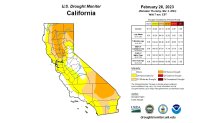More than half of California is drought-free after what was anything but a dry February.
After unrelenting storms brought rain and snow last month, only 49% of the state remains in the moderate drought category, according to this week's U.S. Drought Monitor report. That figure stood at 99% in October at the start of California's water year.
"January was a very wet month for us, and February is going down in the record books," said NBC4 forecaster Belen De Leon. "When we started the water year, we had exceptional, extreme drought conditions all across the state.
Get San Diego local news, weather forecasts, sports and lifestyle stories to your inbox. Sign up for NBC San Diego newsletters.
"Today, things are looking much better. This is a result of all the rain, all the snow."
Moderate drought is the least severe of the four categories in the weekly report. The most severe drought categories were wiped off the map earlier this winter.
U.S. & World
About 25% of the state remains in severe drought, a significant improvement from the start of the water year when 94% of California was in that category.
Drought conditions were eliminated this week along portions of the California coast, including Ventura and Santa Barbara counties, and part of Los Angeles County.
The central Sierra Nevada Mountains and foothills also are out of the drought categories for the first time since January 2020.
”If you look at the precipitation totals we’ve had this year, a colleague has shown that the deficit we’ve accumulated over the last three years – we’ve alleviated that, which is a great thing," Julie Kalansky, the Deputy Director of the Center of Western Weather and Water Extremes at Scripps Institution of Oceanography.
For a state that’s been in a drought, is too much rain a bad thing? According to Kalansky, yes, of course, it can be, and San Diego has seen it in the form of flooding. However, there are other impacts to look out for.
”The research shows that the soil moisture, so how wet that is is a potential pre-cursor to landslides,” Kalansky said. “It has to do with the soil characterizations, the slope, the somewhat to the vegetation, so there are all these competing factors that kind of come together.”
Kalansky emphasized the stark differences between landslides as a result of heavy rain versus burn scars from a fire. She told NBC 7 those triggered by burn scars are often a result of the amount of rain that comes down onto a burn scar in a short amount of time, but is not necessarily impacted by soil moisture.
Although the improvements in the drought monitor are an exciting transition for California, Kalansky also had this to say.
”We live in the most variable climate in terms of rainfall from year-to-year, so even though it’s been a wet year and it’s alleviated much of the drought, we should always be prepared for the next drought.”
California has spent most of the last 15 years in drought. The current dry spell included one of the driest late winters on record.
The state's normal wet season runs from late fall to the end of winter, but dismal precipitation left about 95% of California in severe drought at the start of spring. By September, nearly all of California was in drought.
Much of California’s water comes from melting snow in the Sierra Nevada Mountains. In an ideal scenario, storms blanket the mountains with snow during winter, building up the natural reservoir. That snow then melts in late spring and early summer, replenishing the state's water system. Snowpack was far below normal in Spring 2022.
California's statewide snowpack level was more than 200% above normal in mid-December after powerful December storms blanketed the Sierra Nevada Mountains with snow. That total has improved after February storms brought several more feet of snow.
The water content of the Sierra snowpack, which provides about a third of California's water, is more than 160% of the historical average on April 1, when it is normally at its peak, according to the state Department of Water Resources.




